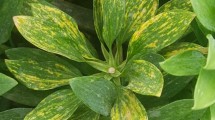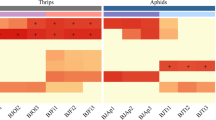Abstract
Background
Chia (Salvia hispanica) is a flowering plant in the family Lamiaceae, which produces seeds that are a rich source of various nutritional compounds.
Objective
To identify a novel RNA virus potentially associated with chia.
Methods
Transcriptome data obtained from developing chia seeds were assembled into contigs. Sequence contigs containing an open reading frame (ORF) that showed amino acid identities with a viral RNA-dependent RNA polymerase (RdRp) were identified and analyzed.
Results
A genomic sequence of a novel plant RNA virus named Salvia hispanica RNA virus 1 (ShRV1) was identified in a chia seed transcriptome dataset. The ShRV1 genome sequence has two ORFs that showed high sequence identities with ORFs of known members of the genus Amalgavirus in the family Amalgaviridae. Amalgaviridae is a family of positive-sense double-stranded non-segmented RNA viruses that infect plants, fungi, and animals. The ShRV1 genome encodes two proteins: a putative replication factory matrix-like protein from ORF1 and an RdRp from the fused ORF of ORF1 and ORF2 by a + 1 programmed ribosomal frameshifting (PRF) mechanism. A conserved + 1 PRF motif sequence UUU_CGU was found at the ORF1/ORF2 boundary. A comparison of 31 amalgavirus ORF1 + 2 fusion proteins revealed that only three positions were repeatedly used as a + 1 PRF site during amalgavirus evolution.
Conclusion
ShRV1 is a novel virus found to be associated with chia and may be useful for studying the molecular features of amalgaviruses.




Similar content being viewed by others
References
Bankevich A, Nurk S, Antipov D, Gurevich AA, Dvorkin M, Kulikov AS, Lesin VM, Nikolenko SI, Pham S, Prjibelski AD et al (2012) SPAdes: a new genome assembly algorithm and its applications to single-cell sequencing. J Comput Biol 19:455–477
Crooks GE, Hon G, Chandonia JM, Brenner SE (2004) WebLogo: a sequence logo generator. Genome Res 14:1188–1190
Debat HJ, Luo Z, Iaffaldano BJ, Zhuang X, Cornish K (2017) Molecular identification and characterization of two Rubber dandelion amalgaviruses. bioRxiv:229443
Depierreux D, Vong M, Nibert ML (2016) Nucleotide sequence of Zygosaccharomyces bailii virus Z: evidence for + 1 programmed ribosomal frameshifting and for assignment to family Amalgaviridae. Virus Res 217:115–124
Edgar RC (2004) MUSCLE: multiple sequence alignment with high accuracy and high throughput. Nucleic Acids Res 32:1792–1797
Goh CJ, Park D, Kim H, Sebastiani F, Hahn Y (2018a) Novel Divavirus (the family Betaflexiviridae) and Mitovirus (the family Narnaviridae) species identified in basil (Ocimum basilicum). Acta Virol 62:304–309
Goh CJ, Park D, Lee JS, Sebastiani F, Hahn Y (2018b) Identification of a novel plant amalgavirus (Amalgavirus, Amalgaviridae) genome sequence in Cistus incanus. Acta Virol 62:122–128
Isogai M, Nakamura T, Ishii K, Watanabe M, Yamagishi N, Yoshikawa N (2011) Histochemical detection of Blueberry latent virus in highbush blueberry plant. J Gen Plant Pathol 77:304–306
Kim DS, Jung JY, Wang Y, Oh HJ, Choi D, Jeon CO, Hahn Y (2014) Plant RNA virus sequences identified in kimchi by microbial metatranscriptome analysis. J Microbiol Biotechnol 24:979–986
Kim H, Park D, Hahn Y (2018) Identification of novel RNA viruses in alfalfa (Medicago sativa): an Alphapartitivirus, a Deltapartitivirus, and a Marafivirus. Gene 638:7–12
Koloniuk I, Hrabakova L, Petrzik K (2015) Molecular characterization of a novel amalgavirus from the entomopathogenic fungus Beauveria bassiana. Arch Virol 160:1585–1588
Krupovic M, Dolja VV, Koonin EV (2015) Plant viruses of the Amalgaviridae family evolved via recombination between viruses with double-stranded and negative-strand RNA genomes. Biol Direct 10:12
Larkin MA, Blackshields G, Brown NP, Chenna R, McGettigan PA, McWilliam H, Valentin F, Wallace IM, Wilm A, Lopez R et al (2007) Clustal W and Clustal X version 2.0. Bioinformatics 23:2947–2948
Li H (2011) A statistical framework for SNP calling, mutation discovery, association mapping and population genetical parameter estimation from sequencing data. Bioinformatics 27:2987–2993
Li H, Durbin R (2009) Fast and accurate short read alignment with Burrows–Wheeler transform. Bioinformatics 25:1754–1760
Li N, Li Y, Zheng C, Huang J, Zhang S (2016) Genome-wide comparative analysis of the codon usage patterns in plants. Genes Genom 38:723–731
Liu W, Chen J (2009) A double-stranded RNA as the genome of a potential virus infecting Vicia faba. Virus Genes 39:126–131
Liu H, Fu Y, Xie J, Cheng J, Ghabrial SA, Li G, Yi X, Jiang D (2012) Discovery of novel dsRNA viral sequences by in silico cloning and implications for viral diversity, host range and evolution. PLoS ONE 7:e42147
Martin RR, Zhou J, Tzanetakis IE (2011) Blueberry latent virus: an amalgam of the Partitiviridae and Totiviridae. Virus Res 155:175–180
Mohd Ali N, Yeap SK, Ho WY, Beh BK, Tan SW, Tan SG (2012) The promising future of chia, Salvia hispanica L.. J Biomed Biotechnol 2012:171956
Nibert ML, Pyle JD, Firth AE (2016) A +1 ribosomal frameshifting motif prevalent among plant amalgaviruses. Virology 498:201–208
Park D, Hahn Y (2017a) Genome sequence of Spinach cryptic virus 1, a new member of the genus Alphapartitivirus (family Partitiviridae), identified in spinach. J Microbiol Biotechnol 27:834–837
Park D, Hahn Y (2017b) Genome sequences of Spinach deltapartitivirus 1, Spinach amalgavirus 1, and Spinach latent virus identified in spinach transcriptome. J Microbiol Biotechnol 27:1324–1330
Park D, Goh CJ, Kim H, Hahn Y (2018) Identification of two novel amalgaviruses in the common eelgrass (Zostera marina) and in silico analysis of the amalgavirus +1 programmed ribosomal frameshifting sites. Plant Pathol J 34:150–156
Pyle JD, Keeling PJ, Nibert ML (2017) Amalga-like virus infecting Antonospora locustae, a microsporidian pathogen of grasshoppers, plus related viruses associated with other arthropods. Virus Res 233:95–104
Reyes-Caudillo E, Tecante A, Valdivia-López MA (2008) Dietary fibre content and antioxidant activity of phenolic compounds present in Mexican chia (Salvia hispanica L.) seeds. Food Chem 107:656–663
Roossinck MJ (2018) Evolutionary and ecological links between plant and fungal viruses. New Phytol
Sabanadzovic S, Valverde RA, Brown JK, Martin RR, Tzanetakis IE (2009) Southern tomato virus: the link between the families Totiviridae and Partitiviridae. Virus Res 140:130–137
Sabanadzovic S, Abou Ghanem-Sabanadzovic N, Valverde RA (2010) A novel monopartite dsRNA virus from rhododendron. Arch Virol 155:1859–1863
Schneider TD, Stephens RM (1990) Sequence logos: a new way to display consensus sequences. Nucleic Acids Res 18:6097–6100
Sreedhar R, Kumari V, Rupwate P, Rajasekharan SD, Srinivasan R M (2015) Exploring triacylglycerol biosynthetic pathway in developing seeds of chia (Salvia hispanica L.): a transcriptomic approach. PLoS ONE 10:e0123580
Torre S, Tattini M, Brunetti C, Guidi L, Gori A, Marzano C, Landi M, Sebastiani F (2016) De novo assembly and comparative transcriptome analyses of red and green morphs of sweet basil grown in full sunlight. PLoS ONE 11:e0160370
Ullah R, Nadeem M, Khalique A, Imran M, Mehmood S, Javid A, Hussain J (2016) Nutritional and therapeutic perspectives of chia (Salvia hispanica L.): a review. J Food Sci Technol 53:1750–1758
Valdivia-López MA, Tecante A (2015) Chia (Salvia hispanica): a review of native Mexican seed and its nutritional and functional properties. Adv Food Nutr Res 75:53–75
Wang K, Jiang S, Sun C, Lin Y, Yin R, Wang Y, Zhang M (2015) The spatial and temporal transcriptomic landscapes of ginseng, Panax ginseng C. A. Meyer Sci Rep 5:18283
Acknowledgements
This research was supported by the Chung-Ang University Research Scholarship Grants in 2018 and by the National Research Foundation of Korea funded by the Government of Korea (Grant No. NRF-2018R1A5A1025077).
Author information
Authors and Affiliations
Corresponding author
Additional information
Publisher’s Note
Springer Nature remains neutral with regard to jurisdictional claims in published maps and institutional affiliations.
Electronic supplementary material
Below is the link to the electronic supplementary material.
Rights and permissions
About this article
Cite this article
Lee, J.S., Goh, C.J., Park, D. et al. Identification of a novel plant RNA virus species of the genus Amalgavirus in the family Amalgaviridae from chia (Salvia hispanica). Genes Genom 41, 507–514 (2019). https://doi.org/10.1007/s13258-019-00782-1
Received:
Accepted:
Published:
Issue Date:
DOI: https://doi.org/10.1007/s13258-019-00782-1




